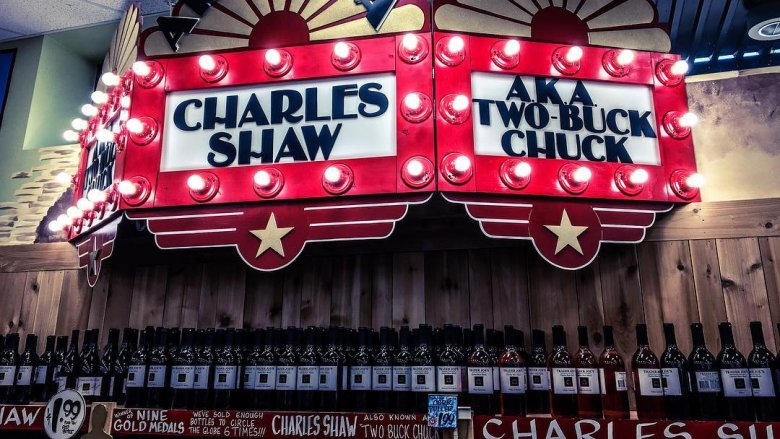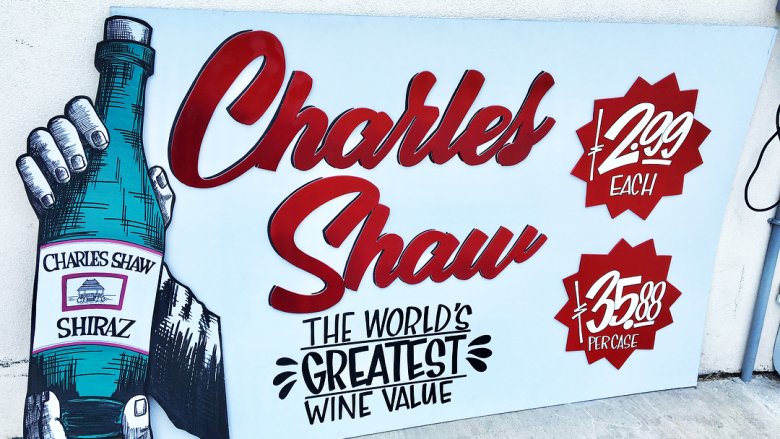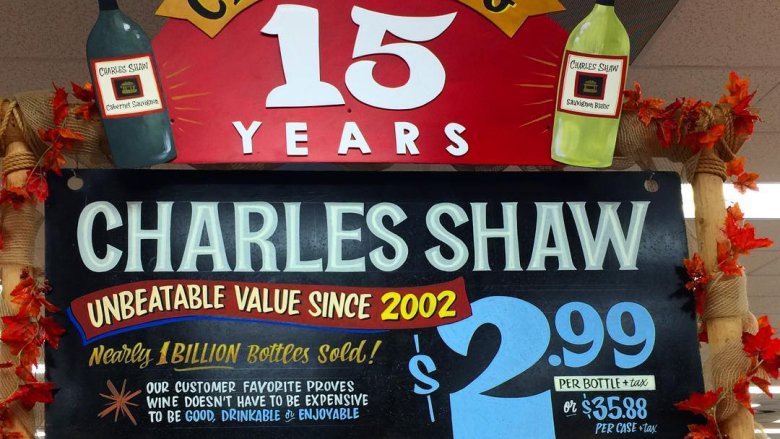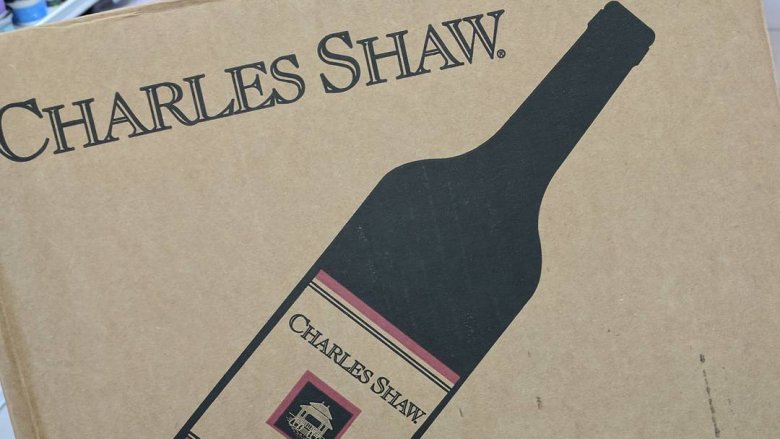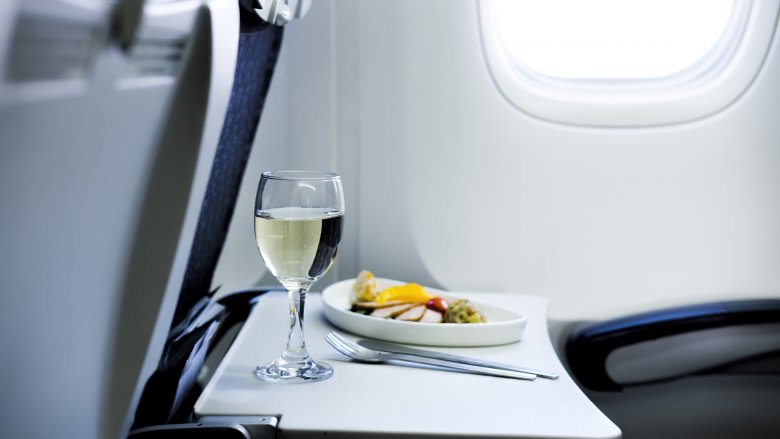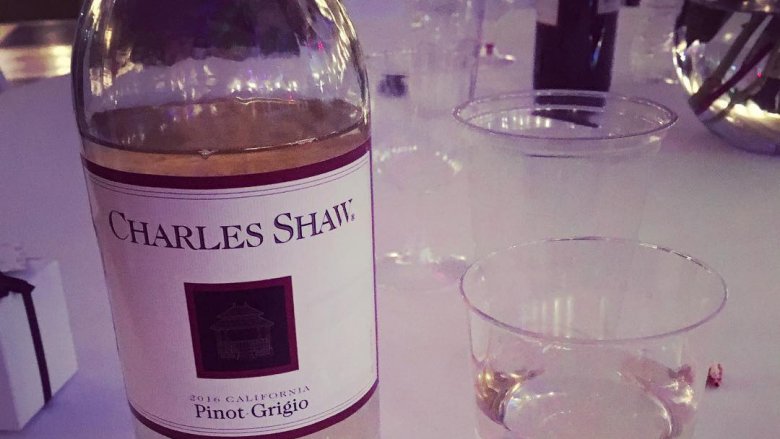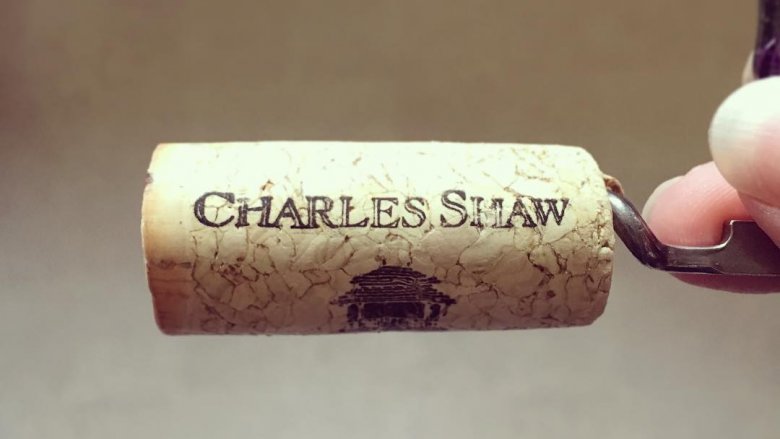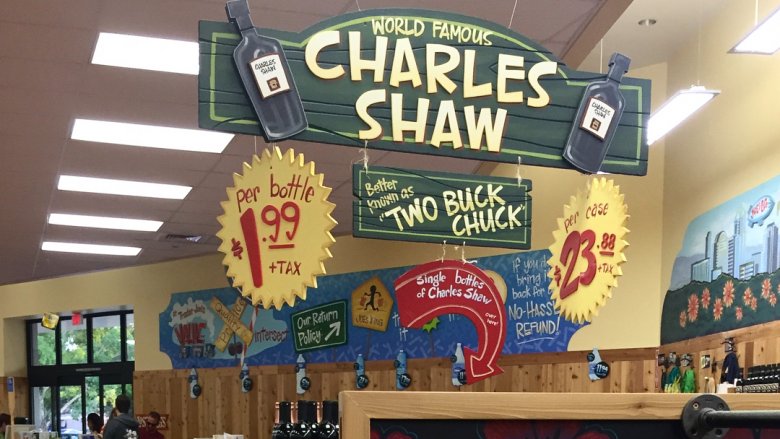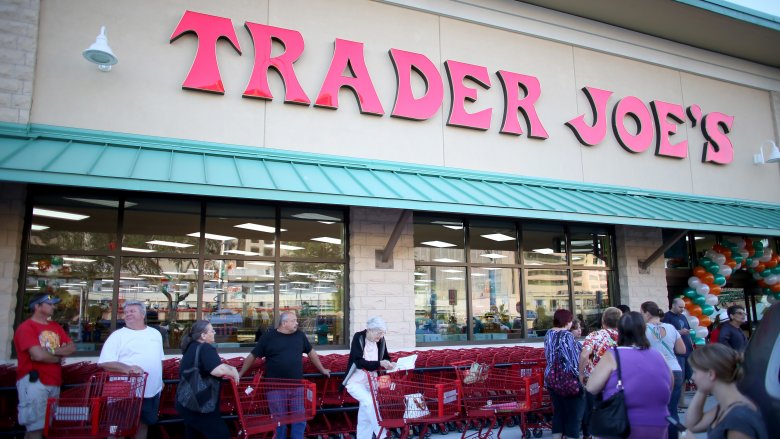The Truth About Trader Joe's Two Buck Chuck
Ever tried Two Buck Chuck? The much beloved, and often maligned "super-value" wine, only available for sale at Trader Joe's stores (that offer booze), has been leaving Trader Joe's doors by the case since they began to offer the brand in 2002.
But how much do you really know about your favorite $2 bottle of vino? Fantastic rumors have swirled since Two Buck Chuck (aka Charles Shaw wines) hit the market. Speculation on how they manage to bring the wine to us at such a ridiculously low cost, urban legends about how the wine ever came to be, and mystery about Charles Shaw himself (does he exist?) make Two Buck Chuck an intriguing wine with an even more intriguing story.
It isn't always two bucks
I remember buying my first ever bottle of "two buck Chuck" at the brand new Trader Joe's in NYC way back in 2005, and being slightly bummed to discover that I was actually buying three buck Chuck. I chalked it up to everything in NYC being pricey, but it turns out that the $2 price tag isn't the standard in every Trader Joe's location. The price of shipping, taxes, and pesky local liquor laws mean the budget price can vary from state to state, with California being the one place you can count on getting a true $2 bottle.
Charles Shaw is a real guy
Yes, Charles Shaw is a real person. And his story is a little bit sad, in the way you might feel sad for a millionaire who squanders his wife's inheritance. Charles Shaw's very real California vineyard did indeed make wine, and it was wine that he wanted people to take very seriously. For a brief time, his wines did enjoy high-praise among aficionados. Some say he was ahead of his time, taking chances on grapes that only later found favor in the market. Fortune took a downward turn for Shaw, and through some questionable business choices, a messy divorce, a bankruptcy, and an entire grape crop lost to a mite infestation, Shaw saw his vineyard sold off to the Franzia family, owner of Bronco Wine Company, which makes Charles Shaw wines today.
So what does Charles Shaw think of his name selling all that cheap wine? He told The Weekly Calistogan that he misses the wine business terribly, and finds Two Buck Chuck to be "embarrassing and demeaning."
How they keep the price so low
It was Bronco who dreamed up the idea of selling a "super-value" wine, and that little idea is one that is now approaching its billionth bottle in sales. But just how do they manage to make a bottle of wine that costs less than some bottles of soda?
Charles Shaw wine is produced in California, but not in the highly sought Napa Valley or Sonoma. Vineyards in the San Joaquin Valley save Bronco big bucks on real estate costs. The wine is fermented with oak chips, instead of pricier wine barrels. The cork is a cheap form of engineered cork — sort of the IKEA furniture of wine corks. The packaging and bottles themselves are made of cheaper, lightweight materials, which are also less expensive to ship. And of course, the demand itself keeps Bronco producing the wine in enormous quantities. The mass production techniques they utilize keep overhead low and decrease labor costs.
It has won some awards
I drank my fair share of Charles Shaw wines when I was living in Brooklyn. I was fond of throwing dinner parties, and always wanted to have plenty of wine on hand for those evenings that lasted into the wee hours. Two Buck Chuck was that wine that came out at the end of the night. It was perfectly drinkable, but not something I was going to present at the start of a soiree.
So I was pretty shocked to learn that some of the Charles Shaw varietals have actually won awards over the years. Back in 2005, the chardonnay won Best Chardonnay from California at the California State Fair Commercial Wine Competition. The cabernet sauvignon, merlot, and white zinfandel have all scored medals at the Orange County Fair wine competition, with only wine makers and professionals as judges. I'll leave it up to you to decide if a wine award really means anything, but at least you have some ammunition in case you ever get teased about bringing Two Buck Chuck to a party.
Was the price connected to 9/11?
Two Buck Chuck's growing popularity in the early 2000s inspired a few wide-spread rumors that sought to explain the sudden explosion in sales of the super-value wines. What people really wanted to know was: how can decent wine be sold so cheaply?
One of the most popular stories claimed that due to new regulations imposed on the airline industry after 9/11, corkscrews were no longer allowed on planes. Large airlines then had no choice but to dump their huge stock of corked wine onto the market, depressing prices. This rumor was, of course, false. Another story with no merit was that Charles Shaw himself was purposely flooding the market with cheap wine, so he could reduce the value of his estate in the midst of bitter divorce negotiations.
We now know the somewhat more boring truth. A dip in the economy created less demand for fine wines, causing an oversupply that led to huge decreases in wine prices.
What does a sommelier think?
The popular consensus among most fans of Two Buck Chuck is that some of it is actually pretty darn good, while some of it is pure swill. Aiming to compile a more scientific list which fans of the wine can turn to, the gang at Thrillist got an actual sommelier (plus a girlfriend with a great palate for good measure) to taste test the most recently available varietals.
And the winner was? With scores of seven and above, the merlot, shiraz, chardonnay, and cabernet sauvignon all did well. The pinot grigio came in at the middle with a score of six. The losers of the bunch were the nouveau, the sauvignon blanc, and the white zinfandel, which was likened to a liquefied Jolly Rancher.
Does Two Buck Chuck contain arsenic?
In March 2015, an independent testing company called Beverage Grades initiated a class-action lawsuit claiming that dozens of cheap California wines were found to contain dangerous levels of inorganic arsenic. Of the many wines on the list, Charles Shaw white zinfandel was said to contain up to three times the acceptable limit of arsenic. The news coverage of the lawsuit created quite a stir among the public, as well as the wine industry.
There was a major problem with the study, however. Since the U.S. does not set acceptable limits for arsenic in wine, Beverage Grades had tested the wine at the same standards that are set for drinking water. It's an unfair comparison, especially considering that all fruit juices are naturally five times higher in arsenic than water. Another major problem with the study? Beverage Grades could profit majorly over the arsenic scare, and even issued a press release offering their testing services to winemakers and retailers who seek "reassurance from arsenic in wine."
While the U.S. might not test for arsenic in wine, the European Union does, and you can rest assured, California wines still find a prominent space on the shelves of European wine shops.
What about that article that said there was animal blood in the wine?
In 2014, the Huffington Post (via Gothamist) ran a then 3-year-old news story, featuring comments posted by a wine shop owner on Quora and his off-the-cuff observations on how Bronco might be able to produce such inexpensive wine. Chris Knox, the wine shop owner, made some wild claims, including that Bronco's mechanical grape-picking tractors were also picking up dead birds, insects, and rodents, and throwing them into the large tanks to ferment along with the grapes, giving us animal blood in our Two Buck Chuck.
The story quickly went viral, prompting Bronco to issue a statement refuting the claims, reassuring the public that the Bronco company ran a state of the art, top-quality operation. Chris Knox also made his own statement, admitting that his descriptions were "grossly oversimplified and exaggerated," and expressing great frustration with his own lack of due diligence, while also marveling at how a 3-year-old rant from an online forum could somehow become a national news story. Huffington Post has since removed the article.
Who started calling it Two Buck Chuck?
A clever nickname, for sure, and one you would imagine was dreamed up in some wine-fueled, all-night marketing meeting in a conference room, but, the truth is, nobody is quite sure who deserves credit for the catchy name. According to the Trader Joe's website: "We wish we could take credit for that, but alas, some other scribe came up with that moniker."
So who could it have been? A snappy wine writer? A bunch of buzzed college kids buying an extra case for a party? Does it matter?
In the same article, Trader Joe's writes, "We do think we know why these wines have struck a chord — they've proven that wine doesn't need to be expensive to be good, drinkable wine. These are not expensive; they are good, and they're very drinkable" (emphasis original).
